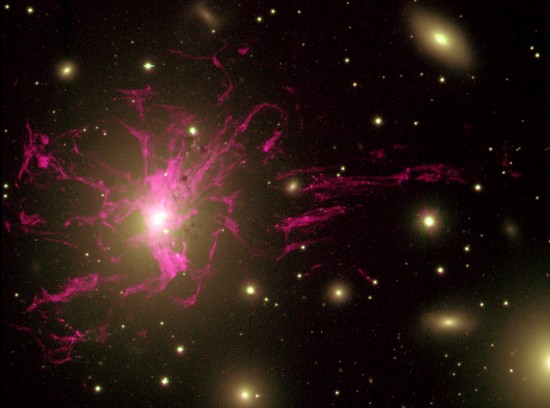From galaxies to the laboratory, transverse electric charge flow accompanies a main discharge channel

On Earth, the main discharge channel is experienced as a terrestrial lighting bolt. Slow-motion studies reveal that each flash is a complex episode. Multiple leader strokes descend from the clouds, while similar, less visible potential contacts rise from the ground. Once two points of contact are made, the electrical energy stored in the cloud-to-ground capacitor discharges, drawing current from several square kilometers.
Cloud-to-surface lightning is accompanied by transverse or “corona discharges” at right angles to the main channel. They appear to be “tributaries” joining the primary discharge. Surface lightning forces close tributaries to be parallel because of electromagnetic forces between them. Brachiated burns or cuts in various materials at different scales are sometimes called “Lichtenberg figures”.

Galaxy NGC 1275. Credit: WIYN 3.5-meter telescope at Kitt Peak National Observatory near Tucson, Arizona, 1999.
Lichtenberg figures are named after Georg Christoph Lichtenberg. They form when lightning bolts strike some material on Earth – it can be soil or even human tissue. They have also been artificially generated in blocks of acrylic plastic. Many Lichtenberg figures have been discovered in the south polar region of Mars.
To understand the connection that plasma formations in space have with laboratory experiments the scalability of plasma phenomena must be considered. Plasma discharges can produce the same formations irrespective of size. Patterns appear in laboratories, on planets, around stars, and inside galaxies. So-called “streamers” are seen inside the shell of gas and dust that makes up the haze around the nucleus of Comet 67P/Churyumov-Gerasimenko. As discussed in previous Picture of the Day articles, the braided filaments are the sign of helical Birkeland currents.
A few years ago, scientists analyzing data from the Hubble Space Telescope announced the discovery of a “threadlike structures” emerging from NGC 1275. The filaments are only 200 light years wide and extend for 20,000 light years. They contain groups of stars enclosed by glowing, ionized shells. Researchers refer to these rapidly moving star cluster knots as “fireballs,” because they look like flaming projectiles shooting out from the galaxy.
Duration is also directly proportional to size. Sparks lasting two or three microseconds in the laboratory might scale up to decade-long events at stellar scales, or millions of years at the galactic scale. Filamentary shapes appear to exist no matter where investigators search. Forces exerted by electrified plasma contained in the twisting filaments of Birkeland currents dominate the Universe. They flow in a cosmic circuit that comes into our field of view and then goes back out into the void with long-range attraction between them.
In the image at the top of the page, NGC 1275 also displays streamers of material moving away from its equatorial plane at right angles. Could it be that corona arc discharges, an electrical phenomenon associated with terrestrial lightning, are occurring on a thousands of light-years scale?
Written by Stephen Smith (The Thunderbolts Project)

Commenting rules and guidelines
We value the thoughts and opinions of our readers and welcome healthy discussions on our website. In order to maintain a respectful and positive community, we ask that all commenters follow these rules.